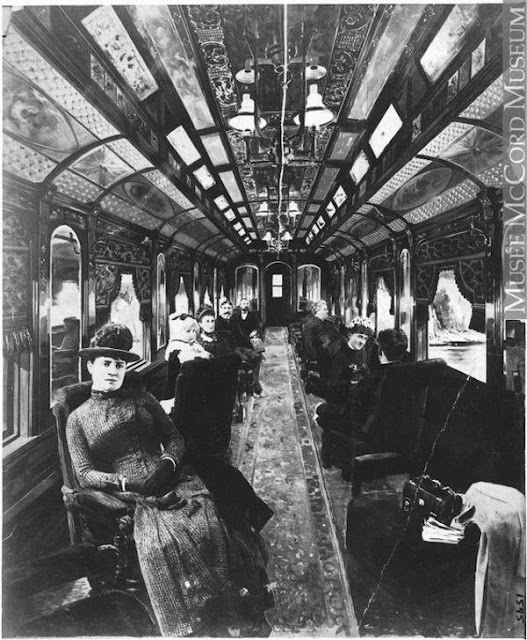In 1814, a man named George Stephenson constructed the first locomotive. In a display that attracted a few spectators, he showed that his engine could pull 30 tons up a hill at 4mph. Over the coming years, many engineers would further develop the locomotive and train to the point where it became a vital part to the growth of our nation. Between 1849 and 1860, 31,000 of railroad were built and many companies such as the Pullman Company were making early moves in to making train travel safe and luxurious for passengers.
In 1865, following the assassination of President Lincoln, the American public got their first look in to the future of train travel when a funeral train was put together and traveled the country. In the following years, as train stations popped up across the U.S., more and more people would take their first trip on a train. This photo collection gives you a rare glimpse in to what it was like to travel by train in the late 1800s.
1. Lincoln's funeral train
 |
| (Lincoln's funeral train) |
Here is a view of Lincoln's funeral train as it pulled out of a station in 1865. Notice the large size of the wheels on the locomotive and the many people who would ride along with the procession. This sparked a thirst for train travel in the minds of the American people.
2. Promontory
 |
| (Promontory) |
A significant development in railroad history came on May 10, 1869 when the East and West were first joined for the Transcontinental Railroad. This opened up an alternative for wealthy people who wanted to head west, but had no interest in going in a covered wagon.
3. Atlanta Union Station in 1871
 |
| (Atlanta Union Station in 1871) |
Key to making train travel accessible for the public was the construction of open, busy train stations in the heart of the major cities on the East coast. These stations rapidly became a hub for merchants as well. This is a view of the Atlanta Union Station in 1871.
4. The first true passenger train (1888 photo)
 |
| (The first true passenger train (1888 photo)) |
This 1888 photo shows our first view at the exterior of a true passenger train that was capable of traveling long distances with hundreds of passengers. These journeys often took weeks, so the engineers made a point to make the accommodations as luxurious as possible. So let's now take a look inside...
5. Old Parlour car interior
 |
| (Old Parlour car interior) |
The Pullman Company debuted their first fancy lounge cars in 1867 and passengers were amazed at the exquisite accommodations. As word spread about the new way to travel being nicer than anything in the city, the Pullman Company continued to build out more cars in all levels of luxury.
6. Pullman parlor car
 |
| (Pullman parlor car) |
Another view of a Pullman car, this one being what was known as an Observation Car. Don't the seats look comfy?
7. Fancy passenger car from around 1875 from the McCord Museum
 |
| (Fancy passenger car from around 1875 from the McCord Museum) |
Here you see a fancy passenger car from around 1875 from the McCord Museum. Everyone wore their finest clothes to travel by train then!
8. B O dining car
 |
| (B O dining car) |
If you go by train now, you likely are familiar with the "cafe car", which is often no more than a small kitchen with some basics. In the late 1800s, however, many trains were outfitted with large kitchens and had full, five-star-level dining rooms and chefs on staff. Can you imagine?
9. Sleeping car (1895 photo)
 |
| (Sleeping car (1895 photo)) |
As more and more people began to travel by train and more companies sprouted up to service them, accommodations began to shift to allow for lower ticket prices. This 1895 photo shows a standard "sleeping car" compartment where people would often sleep sitting up.
10. Evolution of train travel
 |
| (Evolution of train travel) |
This late 1800's photo captures the evolution of train travel quite well. The seats were still velvet and plush, but with much less room. It still looks like it would be an amazing ride, however!
11. Passenger train (1895 Kansas)
 |
| (Passenger train (1895 Kansas)) |
By 1895, trains could move quickly across the nation, as seen here as a passenger train whistles through Kansas.
12. Train Advertising, 1900s
 |
| (Train Advertising, 1900s) |
At the start of the 1900s, train companies began advertising that combined the historical luxury, but also showed the newer seats and accommodations. This type of imagery made train travel even more accessible.
13. Downtown Chicago loading
 |
| (Downtown Chicago loading) |
This early 1900s photo from a station outside of Chicago captures the popularity of train travel at the turn of the century. The fancy Pullman dining cars may have been gone, but in its place came a happy, mobile population of people who could, often for the first time, explore the nation and visit family members everywhere.
